By Donald-Brian Johnson
Abe Lincoln was there. So were the “Flintstones.” Michelangelo’s Pieta paid an exclusive visit. The enormous inhabitants of Sinclair’s “Dinoland” bid folks a toothy welcome. And, it’s where The Riddler executed a dastardly burglary during the pilot episode of TV’s Batman.
During the summers of 1964 and ’65, a gee-whillikers wonderland welcomed one and all to a former New York garbage dump. This was the place to be … a once-in-a-lifetime opportunity to experience “the world of tomorrow—today!”
This was the New York World’s Fair.
And I was there, too.
Twenty-five years earlier, Fair president Robert Moses had overseen the conversion of a marshy dumping ground into Flushing Meadows Park, site of the 1939-40 New York World’s Fair. Now, the time was ripe for a brand-new Fair in the same location, a Fair even grander than its predecessor.
In the official Fair Guidebook, Moses noted that “the Fair aims to be universal, to have something for everyone.” That it did, which is why it retains its significance 50 years after the fact.
Mid-century modern was the Fair’s overriding architectural style. Space-age futurism, in the shape of spheres, spires, and swooping, sweeping, building facades resulted in a design environment just right for the atomic generation. New and more adaptable construction materials, such as plexiglas and stainless steel, meant that anything that could be imagined could very probably be built. Here was a place where that loveable cartoon family, the Jetsons, would be right at home. (In fact, in some Fair advertising materials, they were.)
Capitalizing on the modernistic trend were the Fair’s industrial exhibits. A case in point: General Motors’ Futurama II, where moving chairs slid noiselessly past three-dimensional dioramas, depicting “life in the future.” Twenty-six million ticketholders clamored for their glimpse of what the future would hold, General Motors-style.
After strolling through the pavilions dedicated to individual states, (New York’s, with its looming Phillip Johnson-designed observation towers, was a particular favorite), and checking out rockets in the United States Space Park, fairgoers could see what international exhibitors had to offer. The Belgian Village, home of the “Bel-Gem Brussels Waffle”, (its secret: a hearty helping of strawberries and whipped cream), drew many repeat customers, including yours truly. All that, for an admission charge of just $2 a day, $1 for kids. Even adjusted for inflation ($15 and $7), that’s a world-class deal!
Now, about my own World’s Fair connection: in 1965, as a newly-minted Tenderfoot, I was one of those chosen for the Boy Scout Service Corps. Our job: staffing the Fair’s Boy Scout Pavilion.
So what if we had to solicit donations to pay for our train tickets? Who cared if it meant a summer toiling away for absolutely no pay? Room and board were covered… we had free passes to absolutely everything at the Fair… and, best of all, we could spend our time off (what there was of it) exploring New York City.
On the train ride from Minneapolis to New York, we amused ourselves by breaking open a display kit of bandages and artificial plastic wounds, decking out some lucky Scout—usually me—as an accident victim laying in the aisle. Since everyone had to pass through our area on their way to the dining car, this was especially rewarding, (and shriek-inducing), at mealtimes. Of course, after awhile folks got used to it, and just stepped over us.
At the Fair, after settling into our Fort Totten housing barracks, we were issued old-fashioned Scout ‘campaign’ hats, and our “must-wear-at-all-times” official red nylon Corps jackets. Very eye-catching! However, since the jackets went over our regular khaki uniforms, and this was summertime, many a sweltering Fair day was in store.
Then we were each assigned specific Pavilion duties. Mine: demonstrating mouth-to-mouth resuscitation. My subject: “Resusci-Annie.” Remember her? This lifelike plastic dummy had a full-sized head crowned with wispy blonde hair, and a realistic torso. When resuscitation was performed correctly, Annie’s chest would miraculously rise and fall.
But, time away from Annie was magical. A notebook I kept of activities at the Fair indicates that over the summer, “Don saw 41 exhibits.” Among the favorites: Futurama II; the General Electric Skydome; the Kodak Moondeck; the Vatican Pavilion, with its awe-inspiring Pieta sculpture; the Illinois Pavilion with a walking, talking Abe Lincoln (Disney’s first use of that technology); U.S. Rubber’s 80-foot Ferris Wheel in the shape of a gigantic tire; and, of course, the Pepsi-Cola Pavilion, featuring the “Tower of the Four Winds,” and the debut of Disney’s soon-to-become-legendary ride “It’s A Small World.” During our Small World mini-cruise past multi-national singing and cavorting puppets (all with identical gleeful faces), our boat ground to a halt. But those happy puppets kept on a-singin’ and a-dancin’. We stayed as we were for about half an hour. I still have It’s A Small World committed to memory. Well, at least the chorus with the Swiss yodeler. That’s what kept repeating.
The emphasis of almost every Fair exhibit was on, as General Motors put it, “things yet to come,” and that push toward the future was filled with excitement. Every day at the Fair, there was something new to see … something new to explore. I think I owe much of my lifelong fascination with learning more about the unknown to my Scouting stint at the New York World’s Fair.
For Fairgoers like myself, no visit was complete without an armload of souvenirs, and vendors were happy to oblige. For the camera-challenged, there were “souvenir slide sets” of all the major attractions. Souvenir color brochures touted the glories of both the inspiring—the Vatican Pavilion, “a spark of light, a center of love, a vivifying leaven”— to the ghoulish—Walter’s International Wax Museum, “figures frozen in history – rich beauty in wax – so lifelike they almost seem to breathe.” If you were like me, you enjoyed, and bought brochures of, both.
The Pieta’s unmatched beauty could be taken home (well, sort of), with a Pieta Nightlight. For the younger set, kiddie Fair mascots “Peter and Wendy” were available as rubber dolls; their visages also appeared on everything from coin purses to bath towels. The Flintstones starred in their very own Official Souvenir Comic Book (Fred loses his clamshell wallet; Dino falls hard for Sinclair’s gigantic rubber brontosaurus; all eventually ends well.)
There were flash-card sets of popular exhibits, complete with color illustrations and lots of reference info for teachers and young teachers-to-be. Recordings aurally recaptured for repeat listening back home everything from “The Triumph of Man”, (presented by Travelers Insurance), to (you guessed it), Disney’s It’s A Small World. For those in search of racier puppetry, there was also a recording of Sid and Marty Krofft’s adult marionette show, les Poupées de Paris, featuring a for-the-time all-star voice cast. (Among the notables: Milton Berle, Liberace, and Jayne Mansfield.)
And, then there was the “Unisphere.” Plate after plate, glass after glass, ashtray after ashtray—and that’s just for starters—featured depictions of the Fair’s iconic symbol. An open-grid globe, with solid sections representing the earth’s land masses, the Unisphere was fashioned by and of U.S. Steel. 120 feet in diameter, it towered 140 feet above a 310-foot-wide reflecting pool. According to the Fair Guide, the Unisphere “dramatized the interrelation of the peoples of the world, and their yearning for Peace through Understanding.” Plus, it looked mighty nice on just about any souvenir imaginable. Today, the Unisphere remains one of the few Fair structures still extant.
Even 50 years on, souvenirs of the New York World’s Fair can be acquired in abundance. Hundreds of listings appear regularly on eBay, while specific auction sites, such as Andy Kaufman’s worldsfairauction.com, are devoted entirely to the sale of memorabilia from World’s Fairs. Prices are reasonable: since so many items were produced, many are in the under-$50 range. There are, of course, exceptions. A battery-operated plastic toy replica of U.S. Rubber’s Ferris Wheel tire, complete with tiny occupants, originally sold for just about $20. (I should know. I bought one). Today, even devoid of occupants, it fetches at least several hundred. (But not for me. I lost mine.)
After 1965, the Fair was dismantled in almost its entirety – a boon for collectors who prefer souvenirs of the Fair, as opposed to souvenirs sold at the Fair. While some displays found new life in other venues (that giant Ferris Wheel tire eventually wound up in Allen Park, Michigan), other structural pieces made their way onto the open market. Consequently, décor artifacts such as street lights and building signs remain in great demand with today’s hard-core Fair collectors. Prices are considerably higher than those for “official” Fair souvenirs, since supplies are so limited.
Some fortunate budding collectors had the foresight to think ahead. One such is Gary Holmes. A Fair highlight was the Tower Of Light show, sponsored by independent electric utility companies. Electricity mascot “Reddy Kilowatt” musically introduced a lightbulb-shaped Ben Franklin to the “joys of electrical living.” When the Fair ended, young Gary wrote the exhibitors, asking for old Ben. And they gave it to him. For free.
Around The World
Today, World’s Fairs in U.S. locales are just a distant memory; there hasn’t been one held on our shores since the 1980s. Nowadays, the Far East holds sway, luring visitors to such exotic fair sites as Korea and Shanghai. Those in search of domestic dazzlement need look no further than such destinations as Disney World (the current home of audio-animatronic Abe, and those persistent Small World singing puppets.) In the words of Fair researcher and author Bill Cotter, Disney’s Epcot Center is “like a World’s Fair year-round!”
But for two brief summers during the 1960s, a real World’s Fair, right here in our own backyard, enthralled, entertained, and educated crowds from around the globe. It was the New York World’s Fair, with its gee-whiz, gosh-almighty visions of the future. And wasn’t that future wonderful?
Indeed it was. Scout’s honor.
Donald-Brian Johnson is the co-author of numerous books on design and collectibles, including Postwar Pop, a collection of his columns, and an upcoming second volume. He eventually made it to Eagle Scout. Please address inquiries to: donaldbrian@msn.com.

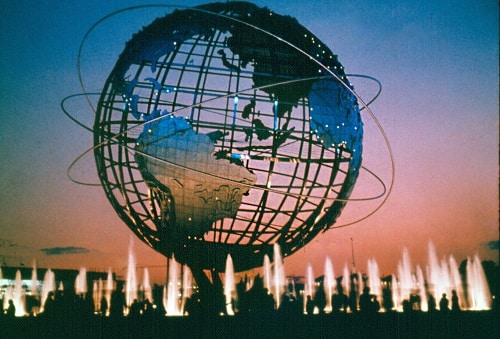

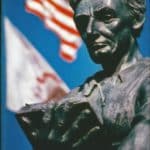
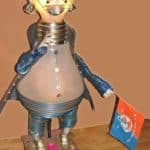
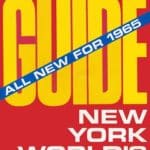

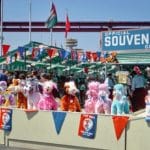

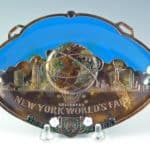
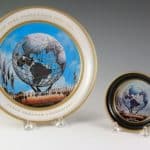
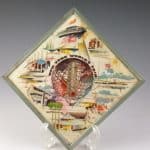
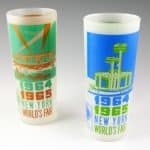
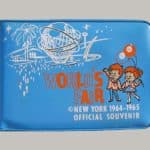
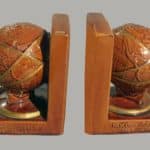
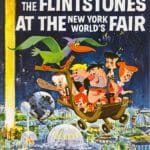
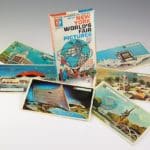
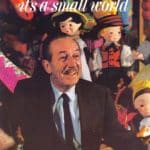



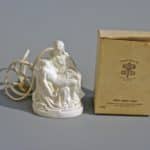
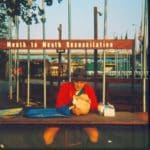
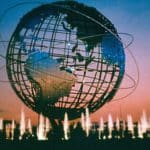



Related posts: